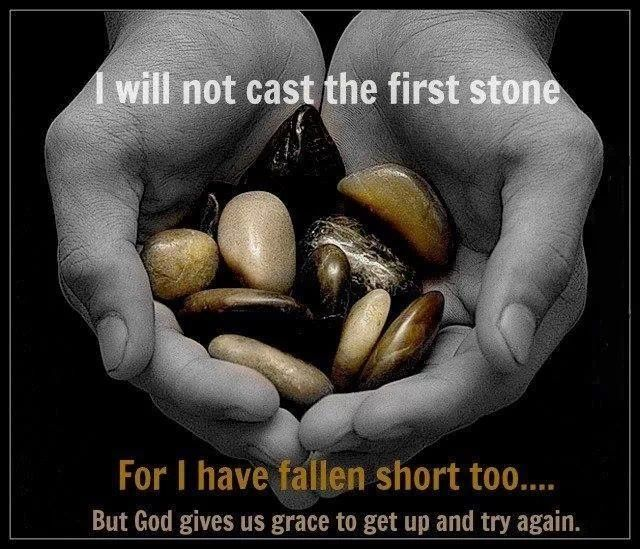CYCLE C . LENT . WEEK 5
REFLECTION
– By Fr Ugo Ikwuka
Archway, London
A woman was using her husband’s credit card so extravagantly. When the husband complained, she reminded him that the sacrament of marriage has made them both one body hence sacramentally speaking, whatever she spends, it is both of them that spent it. The man could not flaw the logic. Soon, the woman caught the man in adultery and was furious. The man asked her to calm down so that they could put heads together and resolve the matter since as one body, it was both of them that sacramentally committed the adultery.
In our Gospel this Sunday, the scribes and the Pharisees brought forward to Jesus in the Temple grounds, a woman caught in adultery whom they wanted to stone.
Jesus had come to the Temple from the Mount of Olives which is east of the Temple. This movement is very significant to the understanding of the Gospel. Recall the vision of the prophet Ezekiel (10:19) where the shekina (Glory of the Lord) departed the Temple from the east gate because of the corruption therein.
The movement of Jesus from the east into the Temple therefore signifies the return of the Glory of the Lord to rid the Temple of corruption and establish its proper purpose.
The purpose of the Law and the Temple rituals is to bring people closer to God; to correct what needs correcting and facilitate friendship between creature and creator. The scribes and the Pharisees exemplify the corruption of the Law and Temple rituals because they use these, not to draw people closer to God, but to persecute the poor and the powerless as demonstrated in their treatment of the woman.
It is like what happens when the police abuse authority to maltreat people in the pretext of enforcing the law. It takes two to commit adultery but there is no mention of the other party, the man. If the law as prescribed in Leviticus 20:10 is to be strictly followed, both the man and the woman should have been stoned. But they humiliate and want to stone the more vulnerable partner.
A Nigerian lady recently suffered a worse fate. She was not only brutalised, stripped naked and thrown out to the public, the whole assault was video-recorded and later broadcast to the world in the social media. All these happened while the male accomplice was left in the comfort and security of the bedroom.
The scribes and Pharisees were clearly being unjust but they were actually not interested in the guilt of the man or the woman. They were using her as a pawn in their plot to entrap Jesus, the rabbi who eats with sinners, by putting him on a collision course with the sacred traditions. It is the way of the world to use others to advance one’s own agenda, career, position etc.
They told Jesus, “Moses ordered us in the Law to condemn women like this to death by stoning. What have you to say?”
If Jesus agrees with Moses, he undermines his own message of love and compassion towards sinners and would of course incur the wrath of the Roman overlords who reserved to themselves the death penalty. If he rejects the Law of Moses, he will be denounced as a questionable man of God who doesn’t love the Law.
But, as usual, Jesus used the opportunity provided by their malice to deliver one of the most telling lines in the Bible, “Let the one without sin be the first to throw the stone.” To their credit, none of them took up the challenge.
They each look inwards at their own inadequacies and gradually disperse beginning with the eldest who, presumably, was the wisest and the most introspective. Only the one without sin can sit in judgment over another. If you live in glass house, you don’t throw stones.

The line from Jesus demonstrates that one of the prime purposes of the Law is to make us humble. That’s why experts will always acknowledge that they still fall short of standards. At post match interviews, we see as best of managers who know the game point out the many rooms for improvement in their teams even in victory. They don’t go humiliating the losers.
Yet, Jesus did not condone the woman’s serious sin of adultery – a breach of trust in the marriage relationship and a serious act of injustice to the innocent spouse. He told her to go but to sin no more.
However, unlike the Pharisees and Scribes, the custodians of the Law, he does not condemn her. He came, not to condemn but to save, to rehabilitate (John 3:17).
Indeed, looking at the woman, Jesus did not see an adulterer. He did not see a sinner; he never does. He rather saw her as she could be. To Jesus, sin has always been an ugly cover that distorts the true beauty of people. It only needs stripping away to reveal the beautiful image of God within. That’s what happens when we approach Jesus in humility; he lifts the cloud of sinfulness and emptiness, restoring us to the fullness of life.
A rabbi once asked his students what criterion might be used to determine that the night had ended. One student said the night had ended when there was enough light to tell a goat from a sheep.
Another said when you could distinguish an apple tree from a fig tree. The rabbi gave this answer: “A new day has arrived when you can look at a human face, and see a brother or a sister. If you are unable to see a brother or a sister in every human face, you are still in the darkness of night.”




